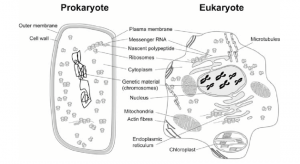What is Prokaryotic and Eukaryotic Cells? – Definition, Diagram, Difference
As you already know, all the components in the atmosphere have cells within them, regardless of whether they are plants or animals. And for a better understanding of how these cells function and the various components each of these cells consists of, as well as their differences. It is essential for the students to know the difference between these two cells, to ease into the other complex chapters and subtopics in this subject.
What are Prokaryotic Cells?
Generally, Prokaryotic Cells are single-celled microorganisms, that are said to be the ancient species on earth, which thrived over millions of years, through the forms like Archaea and Bacteria. Besides, these cells play a major role in the photosynthesis process in plants, through cyanobacteria. Moreover, these cells have certain characteristics which make them unique compared to other types of cells, such as,
- In these cells, important components such as lysosomes, Mitochondria, Chloroplast, and Golgi Bodies are not present.
- The Prokaryotic cell wall is made up of amino acids and carbohydrates.
- Moreover, the nuclear membrane is also absent in the Prokaryotic cells.
- Genetic Materials are limited to a single chromosome.
- Furthermore, histone proteins are also not present in these types of cells.
- Besides, in these cells, the plasma membrane plays a major role in transporting respiratory enzymes.
What are Eukaryotic Cells?
Unlike the Prokaryotic Cells, these cells are much larger in size and have complex structures each having different functions or features. Besides, this cell consists of a cell wall, which functions as a protective barrier to the plasma membrane inside the cell. Moreover, these cells are only found in plants, unlike prokaryotic cells. Examples of Eukaryotic cells are multicellular organisms and all unicellular organisms that have a nucleus. Characteristics of Eukaryotic cells are,
- These cells have a nucleus that is enclosed within the nuclear membrane.
- Mitochondria is present in these types of cells, which play an active role in the creation of energy.
- All genetic information is stored inside the nucleus along with single and linear DNA.
- Cells are usually divided into these cells through the process of mitosis.
- The locomotory organs of these cells are Cilia and Flagella.
- The cytoskeletal structure is present in Eukaryotic Cells.
Diagrams of Prokaryotic and Eukaryotic Cells

In these diagrams, you can observe all the different components that these Eukaryotes and Prokaryotic Cells consist of.
Difference Between Prokaryotic and Eukaryotic Cells
There are many differences between Prokaryotic and Eukaryotic Cells, which we are going to explain in detail below.
| Parameters | Prokaryotic Cells | Eukaryotic Cells |
| Types of Cells | Only Unicellular cells | Multi and Unicellular Cells |
| Mitochondria | Not Present | Present |
| Structure | Small and Simple Structure | Complex Structure |
| Number of Chromosome | Only one Chromosome is present. | A multiple numbers of chromosomes. |
| Formation of Cell Division | It is formed through Binary Fission. | It is formed by Mitosis Process. |
| Type of Reproduction | Asexual | Sexual and Asexual |
| Ribosome Type | Small Ribosomes | Large Ribosomes |
| Presence of Flagella | Flagella is made up of only one fiber and is submicroscopic in size. | Flagella is microscopic in size. |
| Examples | Bacteria and Archaea | Animal and Plant Cells |
| Arrangement of DNA | Circular DNA is found. | Linear DNA is found. |
Components of Eukaryotic and Prokaryotic Cells
From the diagram, as you know, there are many components in both the Eukaryotic and Prokaryotic Cells. If you want to learn more about the purpose or function of these components. Then you can check out our article on the Plant Cell article in our blog, where we will explain detailed all the components, and what roles they place in these cells.
Conclusion
In the above article, we have talked in detail about prokaryotes and eukaryotes, their characteristics, and their differences in great detail. And in this subject, there are multiple complex topics, and chapters, which are hard to understand similar to the Prokaryote Cells and Eukaryote Cells. Thus, we suggest students join online interactive classes offered by Tutoroot Platform, as they come with various amazing benefits for the students. If you want to learn more about these benefits, visit the official platform.
